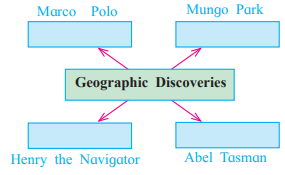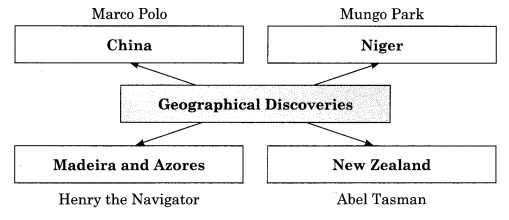Renaissance in Europe and Development of Science
Exercise
Q.1 (A) Choose the correct alternative and rewrite the statement.
1. In 1440, Gutenberg started the printing press.
(a) James Watt (b) Gutenberg (c) Aristotle (d) Homer
2. In 1609, Galileo made a modified telescope.
(a) John Kay (b) Copernicus (c) Galileo (d) Kepler
3. Bartholomew Dias was the first explorer to circumnavigate the African continent.
(a) Henry the Navigator (b) Marco Polo (c) Bartholomew Dias (d) Columbus
(B) Find the incorrect pair from group ‘B’, and write the corrected one.
| Group ‘A’ | Group ‘B’ |
|---|---|
| John Kay | Flying shuttle |
| Samuel Crompton | Cotton gin |
| Edmund Cartwright | Power loom |
| James Watt | Steam engine |
Answer:
Incorrect Pair: Samuel Crompton – Cotton gin
Corrected Pair: Samuel Crompton – Spinning mule
Explanation: The document states that Samuel Crompton invented the “spinning mule” in 1779, while the “cotton gin” was introduced in 1793 for removing cotton seeds from fibers.
Q.2 Write the names of historical places/persons/events.
1. Father of the empirical science:
Answer: Galileo
Explanation: Galileo is referred to as the “Father of the Empirical Science” due to his rational method of empirical observation and theory formation.
2. Scientist who told the world that the centre of our planetary system is the ‘Sun’ and not the ‘Earth’:
Answer: Nicolaus Copernicus
Explanation: In 1543, Copernicus proposed the heliocentric model, stating that the Sun is the center of the planetary system.
3. The treatise written by Varahmihir:
Answer: Brihatsamhita
Explanation: The document mentions that Varahmihir discussed sunspots in his treatise “Brihatsamhita” in the 6th century C.E.
Q.3 Complete the concept map.
Answer:
Q.4 Write short notes.
1. European Crusades
The European Crusades were a series of religious wars (11th to 13th centuries) initiated by European Christians to recapture holy cities like Jerusalem and Bethlehem from Islamic rule. Supported by the Pope, who promised forgiveness of sins, and European rulers with political and economic interests, the Crusades saw participation from common people and merchants. Despite nine campaigns, the Crusades failed due to internal conflicts, lack of cooperation, and vested interests of leaders. They led to the decline of feudalism, increased trade with Central Asia, and introduced Europeans to new goods, technologies, and Arabic knowledge in alchemy, music, and commerce.
2. Metallurgy in Europe
During the Renaissance and Industrial Revolution, metallurgy in Europe advanced significantly. Initially, England relied on iron mines but improved smelting techniques to extract pure iron. Wood was replaced by coal as fuel, enabling furnaces to reach higher temperatures and increase iron production. By 1865, the process of producing steel from molten iron was developed, transforming the iron industry. Methods to cast molten metal into bars (e.g., rails) were also introduced. These advancements supported industrial growth, particularly in manufacturing and infrastructure development.
Q.5 Explain the following statements with reason.
1. The European Renaissance is supposed to have reached its zenith in the 15th-16th centuries.
Reason: The Renaissance, beginning in the 14th century, peaked in the 15th and 16th centuries due to significant developments in art, science, and culture. This period saw the revival of Greek and Roman traditions, the rise of humanism, and groundbreaking scientific discoveries, such as Copernicus’ heliocentric theory and Galileo’s telescope. The invention of the printing press by Gutenberg in 1440 facilitated knowledge dissemination, while artists like Leonardo da Vinci and Michelangelo advanced painting and anatomy. These intellectual and cultural achievements marked the zenith of the Renaissance, laying the foundation for the modern era.
2. The Industrial Revolution first began in England.
Reason: The Industrial Revolution began in England in the 18th century due to several favorable conditions. England had abundant iron ore and coal, essential for industrial production. Its damp climate supported the cotton textile industry. England’s colonies provided cheap raw materials and vast markets for finished goods, generating significant capital. The availability of cheap labor and a capitalistic economy further boosted industrial growth. Inventions like the steam engine by James Watt and textile machinery (e.g., spinning jenny, power loom) mechanized production, making England the epicenter of the Industrial Revolution.
Q.6 State your opinion.
1. The European natural scientists of the 17th century laid the foundations of modern science.
Opinion: I agree with this statement. The 17th-century European scientists, such as Galileo, emphasized empirical observation, experimentation, and the formulation of scientific principles into universal laws. They developed a scientific methodology that prioritized evidence over dogma, as seen in Galileo’s disproval of Aristotle’s theories and the establishment of institutions like the Royal Society. These efforts standardized scientific inquiry, created a new scientific vocabulary, and fostered research in physics, chemistry, and astronomy, forming the bedrock of modern science.
2. The economy based on surplus production supported economic nationalism and also imperialism.
Opinion: This statement is valid. The Industrial Revolution led to surplus production, which necessitated new markets and raw material sources, fueling economic nationalism. European nations imposed restrictions like heavy tolls and trade prohibitions to protect their economies, as seen in England’s colonial policies. This surplus-driven economy also supported imperialism, as nations like England, France, and Germany colonized Asia and Africa to secure resources, labor, and markets. The exploitation of colonies, driven by economic nationalism, reinforced imperial dominance and global economic disparities.
Q.7 Answer the following questions in detail.
1. Explain the causes and effects of European Crusades.
Answer:
Causes:
- Religious Zeal: The Crusades were driven by the Christian desire to reclaim holy cities (Jerusalem, Bethlehem) from Islamic rule, with the Pope promising forgiveness of sins and salvation, inspiring mass participation.
- Political Ambitions: Roman emperors sought to expand their influence over Syria and Asia Minor, while European kings supported the Crusades to gain power and prestige.
- Economic Interests: Merchants from Venice and Genova aimed to establish trade routes to Central Asian markets, leveraging the Crusades to access new trade opportunities.
- Social Factors: Feudal unrest and the promise of spiritual rewards motivated common people to join the Crusades.
Effects:
- Decline of Feudalism: The Crusades weakened feudal structures as peasants gained exposure to new ideas and opportunities, reducing their dependence on lords.
- Loss of Papal Authority: Repeated failures eroded faith in the Pope, challenging the Catholic Church’s dominance.
- Increased Trade: Contact with Central Asia opened new trade routes, boosting commerce in Italian and German cities and fostering a new trader class.
- Military Advancements: Europeans learned advanced fort-building, bridge construction, and warfare tactics, enhancing their military capabilities.
- Cultural Exchange: Europeans adopted Arabic words, technologies (e.g., alchemy), and goods like sugar, silk, and spices, enriching their culture and economy.
2. Give detailed information of the development of science and scientific inventions during the Renaissance period.
Answer:
The Renaissance (14th–16th centuries) marked a transformative period for science, driven by rationalism, humanism, and empirical methods. Key developments include:
- Scientific Methodology: Scientists like Galileo established empirical observation as the basis for theories, earning him the title “Father of the Empirical Science.” His experiments, such as demonstrating equal falling speeds from the Tower of Pisa, disproved Aristotelian views.
- Astronomy: In 1543, Nicolaus Copernicus proposed the heliocentric model, stating the Sun, not the Earth, was the center of the planetary system. Galileo’s improved telescope (1609) supported this theory by observing Jupiter’s moons and the Moon’s surface, proving it was not self-luminous.
- Physics and Chemistry: The invention of gunpowder revolutionized warfare, while alchemy evolved into chemistry, expanding knowledge of metals and elements. Robert Boyle’s discovery of the inverse relationship between gas pressure and volume spurred research on gases like hydrogen and oxygen.
- Inventions: The printing press (Gutenberg, 1440) democratized knowledge, enabling widespread dissemination of scientific ideas. Instruments like the compass, telescope, thermometer, barometer, and microscope facilitated discoveries in navigation, astronomy, and biology.
- Scientific Institutions: Organizations like the Lincean Academy (Rome), Royal Society (London), and French Academy of Sciences promoted research through journals, correspondence, and collaboration, standardizing scientific inquiry.
- Impact on Arts and Education: The scientific approach influenced art, with detailed anatomical drawings by Leonardo da Vinci and oil painting techniques. Universities introduced curricula with Greek literature, science, and ethics, fostering free thinking.



Leave a Reply